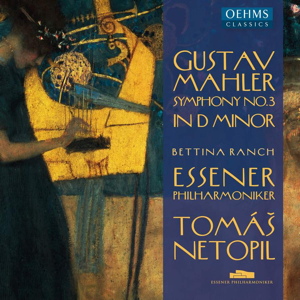
Gustav Mahler (1860-1911)
Symphony No. 3 in D minor
Bettina Ranch (alto), Kinderchor der Deutschen Oper Berlin, Damen des Philharmonischen Chores Essen, Essener Philharmoniker/Tomáš Netopil
rec. January & February 2023, Alfried Krupp-Saal, Philharmonie Essen, Essen, Germany
German texts and English translation
Oehms Classics OC1718 [2 CDs: 98]
I have given a qualified welcome to previous issues in this series of Mahler symphonies, essentially observing that the “Resurrection Symphony” (review) was fine if not especially distinguished and the “Tragic” (review) wholly recommendable without being the most dramatic of readings. Tomáš Netopil here directs the same orchestra in the same venue with the same contralto soloist as in the Second Symphony but with different choral forces and the recording is once more neatly packaged in a cardboard slipcase adorned with Die Musik by Klimt; he and Mahler are a combination irresistible to designers, being almost exact contemporaries, sharing the same forename and likewise both pushing boundaries into dream worlds…
The ever-increasing obstacle to the appreciation of new recordings of staple classical repertoire is that so many classic recordings are already extant in the catalogue. Collectors already have their favourites and anything new must be special indeed to usurp them. In the case of Mahler’s Third Symphony, versions by Bernstein, Tennstedt, Horenstein, Sinopoli, Wit et al are firmly established as benchmark recordings, and given that we have now been enjoying digital sound for over forty years and stereo as standard for nearly seventy, the competition is stiff – and not that many punters compulsively buy every new issue of a favourite work as it appears. My own favourite is by Abbado with the VPO and it seems to me that Netopil’s main problem is that admirable as the Essen Philharmoniker is, it isn’t able to produce the kind of sheen and power we hear from their senior Viennese counterparts.
That comparison is borne out by playing the first five minutes of the symphony by both orchestras; despite the skill of the Essen players, it is apparent that there is an enhanced weight and sonority to the VPO’s playing. Abbado is momentous and magisterial, Netopil is…well, quite grand but nowhere near as monumental. Differences in the timings of the first three movements are negligible, but compared with Abbado, Netopil shaves off nearly four and a half minutes in the fourth, which is significant in a movement marked “Langsam. Ruhevoll. Empfunden.” (Slow. Peaceful. Heartfelt.). However, to be fair, several of the aforementioned conductors come in with a similar timing around the twenty-two minute mark with no loss of gravitas or tenderness. More of that below.
The march section ten minutes into the first movement is especially animated and spritely, culminating in a really rousing first climax at fourteen minutes, and the ensuing “spooky “ section is very atmospheric. Netopil keeps it all together throughout this longest of movements, pressing on with Mahler’s manic procession of brass bands, martial percussion and that imperious phalanx of horns, and the standard of playing by the Essen orchestra is superb. When it is as well played as this throughout the thirty-four minutes of its duration, it is hard not feel at its tumultuous close as if one has already listened to a whole symphony – and Netopil certainly delivers.
The minuet is pertly despatched but its darker elements aren’t underplayed and the strings are suitably slinky and sultry, Netopil’s direction ensuring plenty of rhythmic flexibility and Schwung. The Scherzo is similarly perky and charming but the repeated, galumphing descending octave figure also carries the requisite menace, and the switch in mood in the Trio to the distant post horn is both beautifully played and recorded. I remarked of Bettina Ranch’s contribution to the “Resurrection” that it was “rather heavy on the vibrato; nor is there any special character or beauty to her voice” and my observation here is exactly the same; I fear that without being a liability, she is nonetheless no great asset, as the vocal movements play a pivotal role in the musical drama for all their brevity. More satisfying is the “Bimm bamm” cohort and Ranch’s pulse is less salient in this faster music – although there is some scratchiness in the chorus’ top notes.
The crucial finale is in fact played a little too swiftly for my taste; the opening does not breathe the repose of the best accounts and the extra pace has the unfortunate effect on a modern listener of too vividly recalling the popular Broadway song of the 30s “I’ll be seeing you (again)” – a consequence mitigated by a more reposeful tempo. Nonetheless, again, I have no criticism of the orchestral playing, and there are still moments of great intensity in the unfolding of that lovely melody – including some very fine playing by the lead violinist and other soloists.
I find myself rehashing my verdict on the previous Oehms releases by Netopil and Co. This is a good, often excellent, performance with no special claims to supremacy or even to being the equal of the very best recordings of this great behemoth of a symphony. Back to the topic of my second paragraph above: do we really need another recording?
Ralph Moore
Help us financially by purchasing from




















